Leadership development focuses on enhancing skills through structured activities, fostering growth and self-awareness. PDF guides and workbooks provide frameworks for effective training, ensuring practical application of leadership concepts and continuous improvement.
1.1. Defining Leadership and Its Importance
Leadership is the dynamic process of inspiring, motivating, and guiding individuals or teams to achieve common goals. It involves fostering collaboration, making informed decisions, and driving innovation. Effective leaders cultivate trust, empower others, and create an environment where individuals can thrive. The importance of leadership lies in its ability to transform visions into actionable strategies, ensuring organizational success and personal growth. In educational and professional contexts, leadership training activities, often detailed in PDF guides, emphasize developing these essential skills. By understanding leadership principles, individuals can navigate complex challenges, build strong relationships, and contribute meaningfully to their organizations. Leadership is not just a role but a mindset that drives progress and shapes the future.
1.2. The Role of Training Activities in Leadership Development
Training activities play a pivotal role in shaping leaders by providing practical experiences that enhance essential skills. These activities, often outlined in PDF guides and workbooks, include workshops, simulations, and group exercises. They foster communication, decision-making, and problem-solving abilities, enabling individuals to lead effectively. Experiential learning exercises, such as team-building games and collaborative tasks, encourage hands-on application of leadership concepts. These structured programs help participants develop self-awareness, emotional intelligence, and strategic thinking. By engaging in these activities, individuals gain the confidence and competence to inspire and guide others. Leadership training activities are designed to bridge the gap between theory and practice, ensuring that participants can apply their learning in real-world scenarios. This approach creates well-rounded leaders capable of driving success in both personal and professional settings.
1.3. Overview of Leadership Training Modules
Leadership training modules are structured programs designed to cultivate essential skills and knowledge in aspiring and experienced leaders. These modules often include a combination of theoretical insights and practical exercises, as outlined in PDF guides and workbooks. They typically cover foundational concepts such as defining leadership, communication strategies, and emotional intelligence. Practical components may involve experiential learning exercises, team-building activities, and decision-making simulations. Many modules also incorporate self-assessment tools and reflection exercises to promote personal growth. Trainers and facilitators use these resources to create engaging and effective learning environments. The goal of these modules is to provide participants with actionable strategies and real-world applications, ensuring they can lead with confidence and inspire others to achieve shared objectives. This comprehensive approach ensures that leadership development is both impactful and sustainable.

Key Leadership Skills and Concepts
Leadership skills include communication, emotional intelligence, and decision-making. These concepts, outlined in PDF guides, are essential for effective leadership, fostering collaboration and driving success in teams.
2.1. Communication Skills in Leadership
Effective communication is a cornerstone of leadership, enabling clear expression of ideas and active listening. PDF guides offer structured activities to enhance verbal and non-verbal communication, such as role-playing exercises and group discussions. These tools help leaders articulate vision, provide feedback, and foster open dialogue. Training materials often include icebreakers and collaborative tasks to improve interpersonal connections. For instance, activities like “sticky label exercises” encourage participants to communicate concisely and effectively. Such practices build trust and ensure alignment within teams; Additionally, resources provide techniques for conflict resolution and cross-cultural communication, essential for diverse environments. By mastering these skills, leaders can inspire engagement and drive productivity, making communication a vital component of successful leadership development programs. These activities are widely available in downloadable formats, ensuring accessibility for both trainers and participants.
2.2. Emotional Intelligence and Its Impact
Emotional intelligence (EI) is crucial for effective leadership, enabling leaders to understand and manage their emotions and those of others. PDF guides offer various activities to enhance EI, such as self-assessment tools and reflective exercises. These resources help leaders develop empathy, self-awareness, and interpersonal skills. By improving emotional intelligence, leaders can build stronger relationships, resolve conflicts, and create a positive work environment. Training activities often include group exercises that foster understanding and collaboration. For example, role-playing scenarios allow leaders to practice emotional responses in challenging situations. Cultivating EI leads to more compassionate and resilient leadership, ultimately benefiting both individuals and organizations. These activities are designed to promote personal growth and are widely accessible in downloadable formats, making them valuable for leadership development programs.
2.3. Decision-Making and Problem-Solving Techniques
Effective decision-making and problem-solving are cornerstone skills for leaders, enabling them to navigate complex challenges. Leadership training activities, often detailed in PDF guides, include exercises that simulate real-world scenarios, fostering critical thinking and strategic planning. Techniques such as SWOT analysis, root cause identification, and prioritization frameworks are commonly taught. These tools help leaders evaluate options, anticipate outcomes, and make informed decisions. Problem-solving activities encourage collaboration, creativity, and adaptability, essential for addressing organizational issues. By practicing these techniques, leaders can enhance their ability to lead with confidence and precision. Many resources provide step-by-step guides and case studies to reinforce learning, ensuring leaders are prepared to handle diverse challenges effectively. These practical approaches make decision-making and problem-solving accessible and actionable for all skill levels.
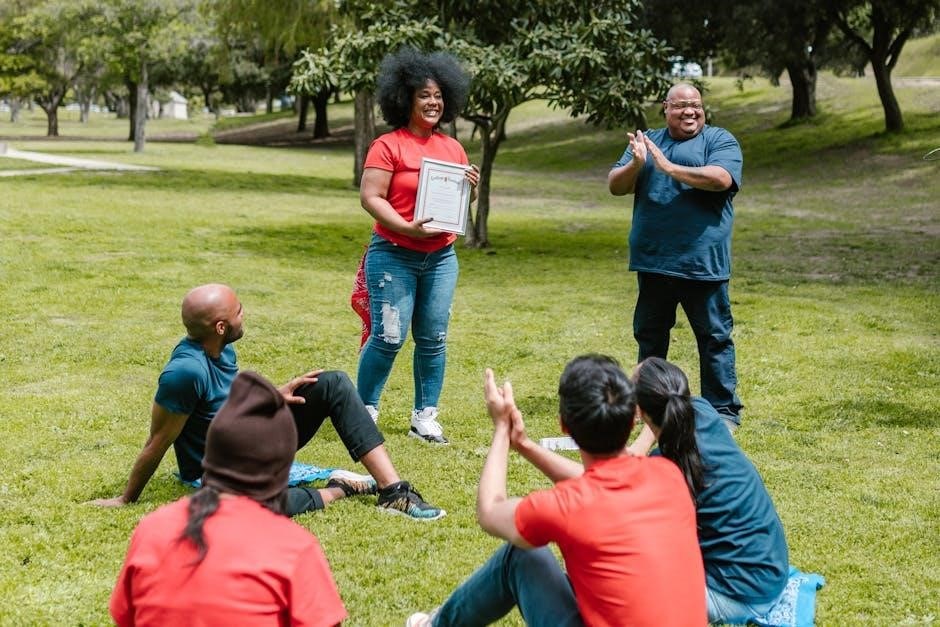
Team Building and Collaboration Activities
Team building activities foster collaboration and trust, essential for effective leadership. PDF guides offer exercises like problem-solving simulations and communication games to enhance group dynamics and shared goals.
3.1. Experiential Learning Exercises for Teams
Experiential learning exercises are interactive and hands-on activities designed to foster teamwork, communication, and problem-solving skills. These exercises, often outlined in PDF guides, encourage teams to learn by doing, rather than passive instruction. Examples include trust-building games, group challenges, and role-playing scenarios that simulate real-world leadership situations. For instance, activities like the “Leader Drawing Exercise” or “Peek-a-Who” promote collaboration and creativity while breaking down barriers. Trainers and facilitators can use these exercises to create dynamic learning environments where participants can practice leadership behaviors, receive feedback, and reflect on their experiences. Such exercises are particularly effective for developing emotional intelligence, adaptability, and decision-making abilities. By engaging in these practical exercises, teams build stronger relationships and enhance their ability to work together toward common goals, making them invaluable for leadership development programs.

3.2. Trust-Building Games and Exercises
Trust-building games and exercises are essential for fostering strong team relationships and collaboration. These activities, often detailed in PDF guides, are designed to promote mutual respect, open communication, and reliance among team members. Examples include icebreakers like “Hog Call” and interactive games such as “Peek-a-Who,” which encourage laughter and teamwork while breaking down barriers. Trust-building exercises, such as group challenges or role-playing scenarios, help participants learn to depend on one another and work collectively toward shared goals. By creating a safe and supportive environment, these activities strengthen emotional bonds and enhance teamwork. Trainers can use these exercises to help teams develop trust, which is critical for effective leadership and collaboration. Regular engagement in such activities ensures sustained trust and improved overall team performance, making them a vital component of leadership development programs.
3.3. Collaborative Problem-Solving Activities
Collaborative problem-solving activities are designed to enhance teamwork and leadership by encouraging participants to work together to address challenges. These exercises, often outlined in PDF guides, focus on fostering creativity, critical thinking, and effective communication. Activities such as group brainstorming sessions, case studies, and role-playing scenarios help teams develop strategies to overcome obstacles. For example, the “Leader Drawing Exercise” involves collaborative discussions to define leadership, aligning individual perspectives with shared goals. Such exercises promote active participation, teamwork, and the application of leadership skills. By engaging in these activities, participants learn to value diverse perspectives and work collectively toward solutions. These collaborative efforts not only strengthen problem-solving abilities but also build a sense of unity and shared responsibility among team members, making them essential for leadership development programs.
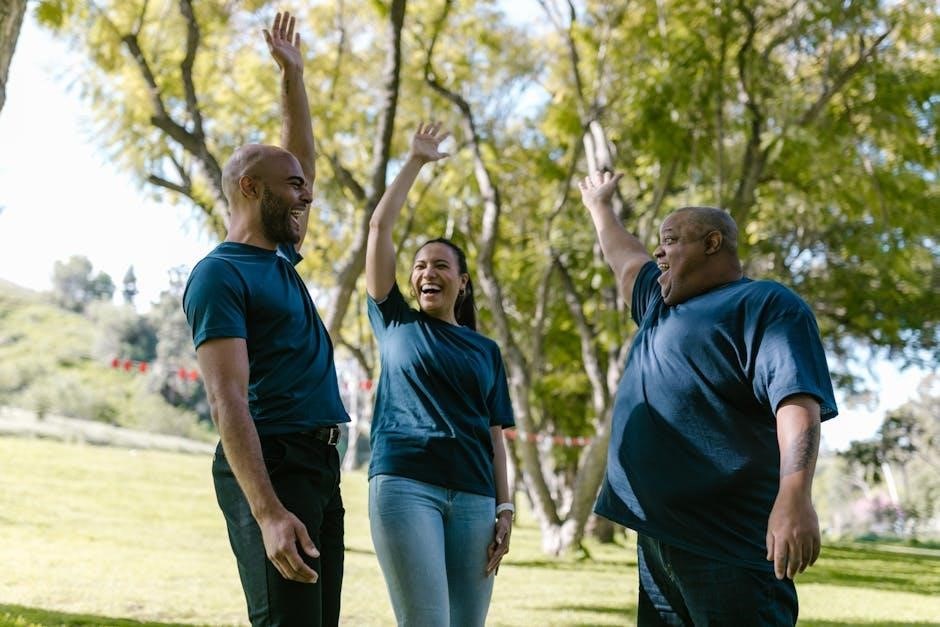
Self-Reflection and Personal Growth
Self-reflection and personal growth are vital for leaders, involving self-assessment tools and journaling exercises to identify strengths and areas for improvement, fostering intentional development and goal-setting.
4.1. Self-Assessment Tools for Leaders
Self-assessment tools are essential for leaders to evaluate their skills and identify areas for growth. These tools, often available in PDF guides, include questionnaires, surveys, and reflection exercises that help leaders measure their communication, decision-making, and emotional intelligence. By using these tools, leaders can gain insights into their strengths and weaknesses, enabling them to create personalized development plans. Many self-assessment tools also provide frameworks for understanding leadership styles and team dynamics. They are widely used in leadership training programs to foster accountability and continuous improvement. Regular use of these tools encourages leaders to reflect on their progress and align their actions with organizational goals. Effective self-assessment is a cornerstone of personal and professional growth, empowering leaders to take charge of their development journey.
4.2. Journaling and Reflection Exercises
Journaling and reflection exercises are powerful tools for leaders to explore their experiences and emotions, fostering self-awareness and personal growth. These activities encourage leaders to document their challenges, successes, and learnings, providing a space for introspection. By regularly reflecting on their actions and decisions, leaders can identify patterns, develop emotional intelligence, and refine their leadership style. Many leadership training programs incorporate journaling as a way to deepen understanding and application of skills. Reflection exercises often include guided prompts or questions, helping leaders connect their experiences to broader leadership concepts. This practice not only enhances self-awareness but also supports the development of a growth mindset. Over time, journaling and reflection become invaluable habits for leaders seeking to improve continuously and lead with intention and purpose.
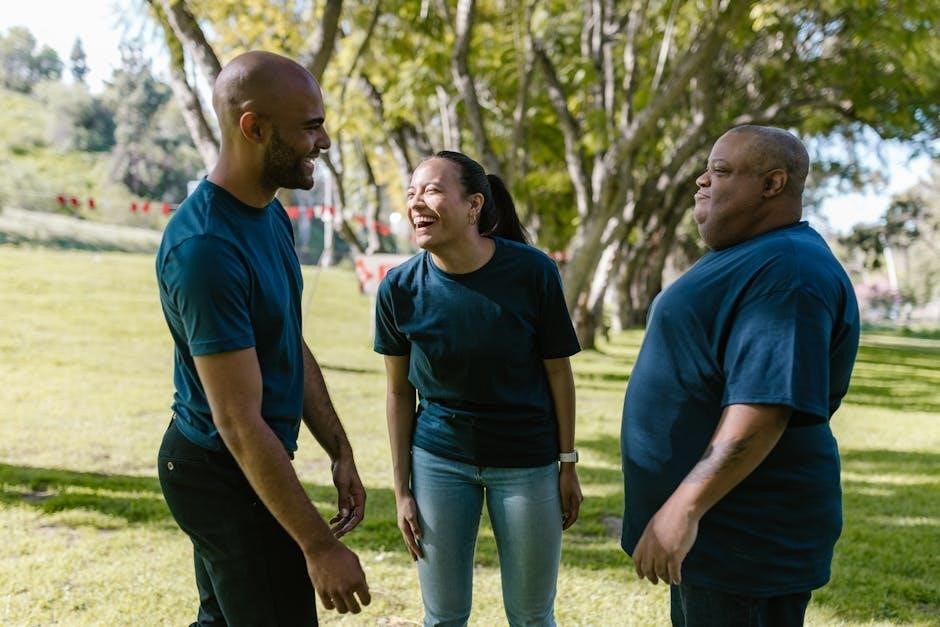
4.3. Setting Personal and Professional Goals
Setting personal and professional goals is a cornerstone of effective leadership development. Leaders who establish clear, actionable objectives are better equipped to guide their teams and achieve organizational success. Goal-setting exercises often involve identifying short-term and long-term targets, aligning personal aspirations with professional responsibilities. Many leadership training programs emphasize the importance of SMART goals—Specific, Measurable, Achievable, Relevant, and Time-bound—to ensure clarity and focus. Tools such as goal-setting worksheets and reflection exercises, often available in PDF guides, help leaders outline their vision and track progress. By regularly reviewing and adjusting their goals, leaders can stay motivated and adapt to changing circumstances. This practice fosters accountability, resilience, and a forward-thinking mindset, enabling leaders to navigate challenges and inspire their teams to strive for excellence.

Leadership Training Resources and Tools
Leadership training resources include PDF guides, workbooks, and online platforms offering structured facilitation techniques and tools to enhance learning and development for aspiring leaders.
5.1. Recommended PDF Guides and Workbooks
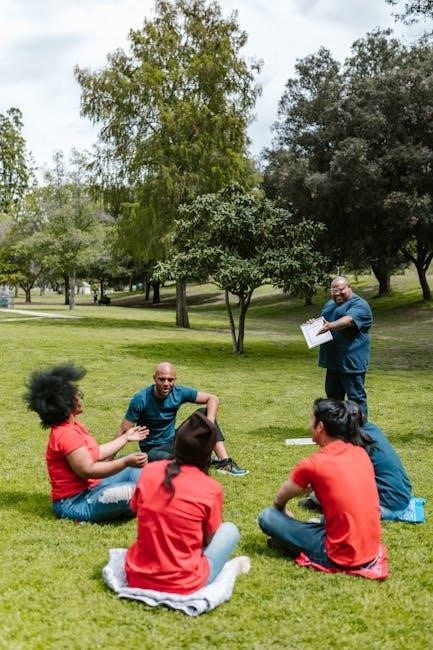
Recommended PDF guides and workbooks are essential resources for leadership development, offering structured frameworks for personal and professional growth. These materials often include self-assessment tools, real-world case studies, and practical exercises to enhance leadership skills. For instance, the Trainers Handbook of Leadership Development provides a wide variety of tools and techniques for facilitators. Additionally, documents like Formation of Leadership Qualities in Students and Leadership Development: Group Activity offer insights into cultivating leadership in educational and professional settings. These guides are designed to be accessible, with many available for free download, making them invaluable for HR managers, trainers, and individuals seeking to improve their leadership abilities. By leveraging these resources, participants can gain a deeper understanding of leadership concepts and apply them effectively in real-world scenarios.
5.2. Online Platforms for Leadership Development
Online platforms have become indispensable for modern leadership development, offering a wide range of tools and resources. Websites like TeachWithMovies.com provide movie learning guides that tie cinematic experiences to leadership concepts. Platforms such as Leadership Development: Group Activity and Academy of Management Learning & Education feature interactive modules and exercises designed to enhance leadership skills. These resources often include downloadable materials, such as PDF workbooks and activity guides, to support personalized learning. Online communities and forums also allow leaders to collaborate, share experiences, and gain insights from peers. Additionally, many platforms offer self-assessment tools and progress tracking, enabling individuals to monitor their growth. By leveraging these digital resources, leaders can access flexible, engaging, and effective training opportunities tailored to their needs.
5.3. Facilitation Techniques for Trainers
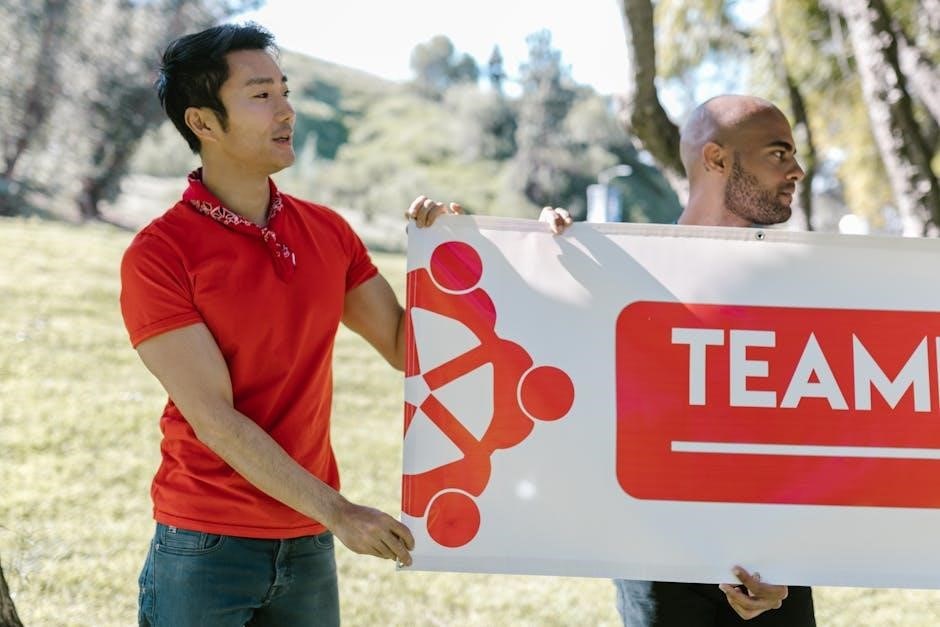
Effective facilitation techniques are essential for trainers to deliver impactful leadership development programs. Trainers can utilize experiential learning exercises, such as team-building games and problem-solving activities, to engage participants actively. Tools like PDF workbooks and handouts provide structured frameworks for exercises, ensuring clarity and focus. Platforms offering downloadable resources, such as www.amacombooks.org/leadershipact, allow trainers to access customizable materials. Incorporating interactive elements, such as group discussions and real-life scenario simulations, fosters collaboration and practical application of leadership skills. Trainers should also encourage feedback loops and personal reflection to deepen learning. By combining these techniques, trainers can create dynamic, inclusive environments that cater to diverse learning styles and promote sustainable leadership growth. Effective facilitation ensures that participants not only gain knowledge but also develop the confidence to apply it in real-world contexts.

Measuring the Impact of Leadership Training
Evaluating training effectiveness involves using assessment tools and feedback mechanisms to measure skill development and behavioral changes. Regular evaluations ensure the program’s alignment with desired leadership outcomes and goals.
6.1. Assessing Leadership Development Progress
Assessing leadership development progress involves using structured tools and exercises to evaluate skill mastery and behavioral changes. Self-assessment guides and feedback sessions help leaders identify strengths and areas for improvement. Activities like “Understanding Yourself/Your Role” encourage reflection and growth. Regular evaluations ensure alignment with organizational goals, fostering continuous development. These assessments often include practical exercises, such as team-building games and decision-making challenges, to measure real-world application of leadership skills. By tracking progress, leaders can refine their approaches and achieve long-term success. PDF workbooks and online platforms provide additional resources for structured assessment and personalized growth plans.
6.2. Feedback Mechanisms for Continuous Improvement
Feedback mechanisms are essential for fostering continuous improvement in leadership development. Structured surveys, peer reviews, and self-assessment tools help gather insights on leadership behaviors and skill application. Group activities and open discussions encourage leaders to share experiences and receive constructive feedback. These mechanisms ensure alignment with organizational goals and promote adaptability. By integrating feedback into training programs, leaders can refine their strategies and address gaps effectively. Regular feedback loops also enhance accountability and motivation, driving sustained growth. Tools like communication exercises and decision-making challenges provide practical opportunities for feedback, enabling leaders to improve continuously. This iterative process supports the development of well-rounded, effective leaders capable of navigating complex challenges.
6.3. Evaluating the Effectiveness of Training Activities
Evaluating the effectiveness of leadership training activities ensures that programs deliver measurable results. Feedback surveys, practical assessments, and performance reviews are common methods used to gauge impact. PDF guides and workbooks often include evaluation metrics to track progress. Leaders can assess skill improvement through real-world application of concepts learned. For instance, communication exercises and decision-making challenges provide tangible outcomes. Trainers use these evaluations to refine training content and delivery, ensuring alignment with organizational goals. Continuous improvement is achieved by identifying gaps and adjusting activities accordingly. Effective evaluation ensures that leadership development initiatives remain relevant and impactful, fostering growth and competency in leaders. This iterative process supports long-term success and adaptability in dynamic environments.
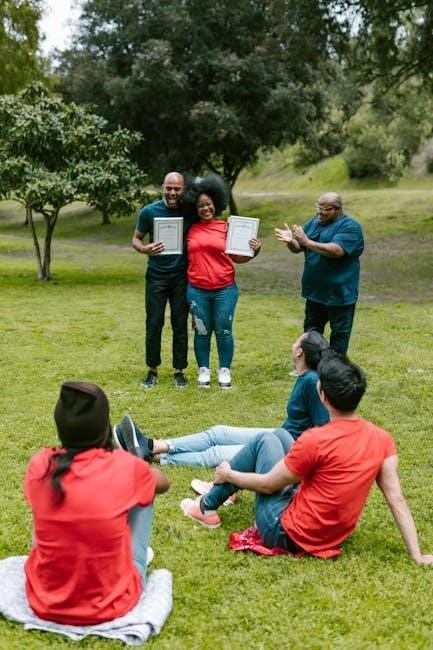
Leave a Reply
You must be logged in to post a comment.